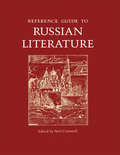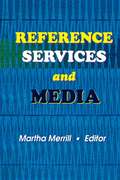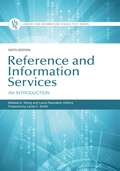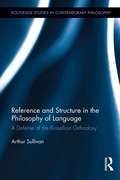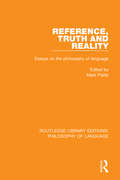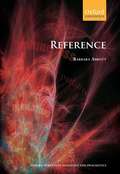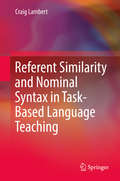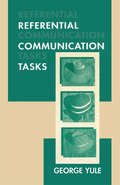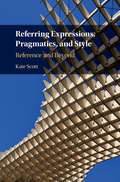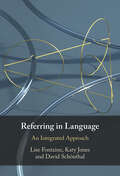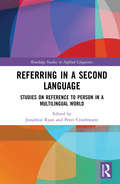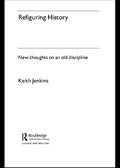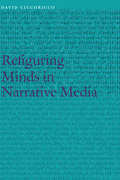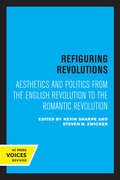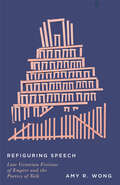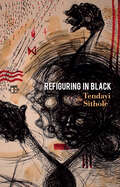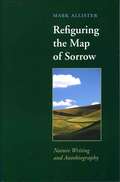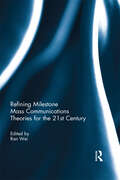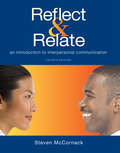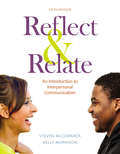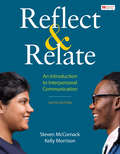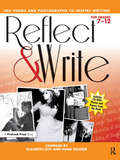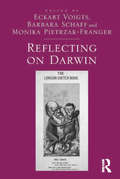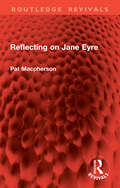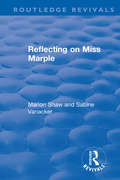- Table View
- List View
Reference Guide to Russian Literature
by Neil CornwellFirst Published in 1998. This volume will surely be regarded as the standard guide to Russian literature for some considerable time to come... It is therefore confidently recommended for addition to reference libraries, be they academic or public.
Reference Services and Media
by Linda S KatzGet the most out of your reference information systems and technology!Reference Services and Media meets the information challenges that overwhelm and assist us today with computerization, electronics, and telecommunications changes in the reference services of our libraries. As a professional in the library science field, you will discover innovative theories and researched solutions on many technology problems and challenges such as formatting and compatibility, training of reference professionals and library users, costs, and information have and have nots. With the year 2000 and beyond upon us, emerging technologies afford tremendous opportunities for reference librarians and for improved and enhanced public access to information. In Reference Services and Media you will learn about planning for staffing, troubleshooting fund-raising, and budget developing to support the use of information technologies. You will also examine the impact new media has on academic libraries, specifically video and movie clips that are transferred over intranets and internets and their opportunities and legal implications. In Reference Services and Media you will also explore:desktop conferencing and web access for reference services versus personalized contactdesktop conferencing with personal computers in remote areas for reference service assistancepositive and negative aspects of using each technology in reference use instruction creative methods for procuring funding for an electronic information literary instruction classroomproviding a digital library for a state library networkraising confidence levels of public service librarians in using electronic resources to answer reference questions Reference Services and Media includes case studies, tables, and an annotated bibliography that serves as a librarian's media reference toolkit, making it essential for effective media reference work. An excellent source for the reference librarian, Reference Services and Media will assist you in adopting and incorporating new information technologies for the present and future.
Reference and Information Services: An Introduction (Library and Information Science Text Series)
by Melissa A. Wong Laura SaundersThis new edition of the classic text Reference and Information Services has been thoroughly updated to reflect current information in the field.| This revised and updated sixth edition of Reference and Information Services continues the book's rich tradition, covering all phases of reference and information services with less emphasis on print and more emphasis on strategies and scenarios.| Reference and Information Services is the go-to textbook for MSLIS and i-School courses on reference services and related topics. It is also a helpful handbook for practitioners. Authors include LIS faculty and professionals who have relevant degrees in their areas and who have published extensively on their topics. ||The first half of the book provides an overview of reference services and techniques for service provision, including the reference interview, ethics, instruction, reader's advisory, and services to diverse populations including children. This part of the book establishes a foundation of knowledge on reference service and frames each topic with ethical and social justice perspectives. ||The second part of the book offers an overview of the information life cycle and dissemination of information, followed by an in-depth examination of information sources by types, including dictionaries, encyclopedias, indexes, and abstracts, as well as by broad subject areas including government, statistics and data, health, and legal information. This second section introduces the tools and resources that reference professionals use to provide the services described in the first half of the text.| | Reference and Information Services is a recognized textbook for information retrieval courses and updates the previous edition | Editors and contributors are experts in the field | Activity boxes engage readers and invite them to reflect on what they are learning and to practice skills through real-life exercises | Conscious integration of critical theory and social justice perspectives offers critical reflection on the standards and practices of the field and encourages readers to consider alternate perspectives
Reference and Structure in the Philosophy of Language: A Defense of the Russellian Orthodoxy (Routledge Studies in Contemporary Philosophy)
by Arthur SullivanThis volume investigates the precise contours of the connections between two foundational concepts: reference (the means of semantically expressing singular or object-dependent information) and structure (the having or lacking of meaningful sub-parts). Sullivan shows that the notion of structure, properly excavated, underlies and grounds various important points in the theory of reference. As such, this work builds on and further develops work by Bertrand Russell, Saul Kripke, David Kaplan, and Stephen Neale – principally, among many others. Sullivan aims to clearly establish the intrinsic connections between structure and reference, which brings into focus informative and explanatory connections underlying otherwise disparate debates about various aspects of linguistic communication. The overall result is a simple, comprehensive lens that can help to clarify a wide range of semantic phenomena.
Reference, Truth and Reality: Essays on the Philosophy of Language (Routledge Library Editions: Philosophy Of Language Ser.)
by Mark PlattsThe papers in this collection discuss the central questions about the connections between language, reality and human understanding. The complex relations between accounts of meaning and facts about ordinary speakers’ understanding of their language are examined so as to illuminate the philosophical character of the connections between language and reality. The collection as a whole is a thematically unified treatment of some of the most central questions within contemporary philosophy of language.
Reference: Oxford Surveys in Semantics and Pragmatics
by Barbara AbbottThis book introduces the most important problems of reference and considers the solutions that have been proposed to explain them. Reference is at the centre of debate among linguists and philosophers and, as Barbara Abbott shows, this has been the case for centuries. She begins by examining the basic issue of how far reference is a two place (words-world) or a three place (speakers-words-world) relation. She then discusses the main aspects of the field and the issues associated with them, including those concerning proper names; direct reference and individual concepts; the difference between referential and quantificational descriptions; pronouns and indexicality; concepts like definiteness and strength; and noun phrases in discourse. Professor Abbott writes with exceptional verve and wit. She presupposes no technical knowledge or background and presents issues and analyses from first principles, illustrating them at every stage with well-chosen examples. Her book is addressed in the first place to advanced undergraduate and graduate students in linguistics and philosophy of language, but it will also appeal to students and practitioners in computational linguistics, cognitive psychology, and anthropology. All will welcome the clarity this guide brings to a subject that continues to challenge the leading thinkers of the age.
Referent Similarity and Nominal Syntax in Task-Based Language Teaching
by Craig LambertThis volume addresses an important gap in the literature on task design and second language use. Building on insights from over 50 years of research on the relationship between task demands and language use, it examines how referent similarity relates to developmentally-relevant variation in the use of nominal structures, comparative structures and abstract lexis among first and second language speakers of English. In addition to providing an empirical basis for future research on tasks, it shares both theoretical and practical information on task design, which will greatly benefit curriculum and material developers.
Referential Communication Tasks: Referential Communication Tasks (Second Language Acquisition Research Series)
by George YuleReferential communication is the term given to communicative acts, generally spoken, in which some kind of information is exchanged between one speaker and another. This information exchange is typically dependent on successful acts of reference, whereby entities (human and non-human) are identified (by naming or describing), are located or moved relative to other entities (by giving instructions or directions), or are followed through sequences of locations and events (by recounting an incident or a narrative). These "activities" are examples of events that are more typically described as "tasks" in the area of second language studies. These might be real world tasks encountered in everyday experience or pedagogical tasks specifically designed for second language classroom use. This volume comprehensively documents and describes the veritable explosion of task-based research in language acquisition. In a succinct, yet easily accessible fashion, it presents the origins, principles, and key distinctions of referential communication research in first and second language studies, complete with exhaustive analyses and illustrations of different types of materials. The author also describes and evaluates different choices for using or modifying these materials, provides analytic frameworks for focusing on various aspects of the data elicited by these tasks, and includes an extensive bibliography plus an appendix showing original task materials.
Referring Expressions, Pragmatics, and Style: Reference and Beyond
by Kate ScottReference is a major theme in the study of language and language use. Providing a relevance-theoretic account of reference resolution, this book develops our understanding of procedurally encoded meaning by exploring its function and role in reference resolution. A range of referring expressions are discussed, including definite descriptions, demonstratives and pronouns. Existing work on the pragmatics of reference has largely focused on how reference is resolved. However, speakers can do much more than just secure reference when they use a referring expression. A speaker's choice of expression might communicate information about their attitudes and their emotions, and referring expressions can also be used to create stylistic and poetic effects. The analyses in this book widen the focus to consider these broader effects, and the discussions and arguments presented take seriously the idea that referring expressions can contribute to meaning and communication in a way that goes beyond reference.
Referring in Language: An Integrated Approach
by Lise Fontaine David Schönthal Katy JonesReferential expressions include terms such as determiners, proper names, noun phrases, pronouns, and all other expressions that we use to make reference to things, beings, or events. The first of its kind, this book presents a detailed, integrated account of typical and atypical uses of referential expressions, combining insights from discourse, cognitive, and psycholinguistic literature within a functional model of language. It first establishes a foundation for reference, including an overview of key influences in the study of reference, the debates surrounding (in)definiteness, and a functional description of referring expressions. It then draws on a variety of approaches to provide a comprehensive explanation of atypical uses, including referring in an uncollaborative context, indefinite expressions used for definite reference, reference by and for children, and finally metonymic reference with a special focus on metonymy in medical contexts. Comprehensive in scope, it is essential reading for academic researchers in syntax, discourse analysis, and cognitive linguistics.
Referring in a Second Language: Studies on Reference to Person in a Multilingual World (Routledge Studies in Applied Linguistics)
by Jonathon Ryan Peter CrosthwaiteThe introduction and tracking of reference to people or individuals, known as referential movement, is a central feature of coherence, and accounts for “about every third word of discourse”. Located at the intersection of pragmatics and grammar, reference is now proving a rich and enduring source of insight into second language development. The challenge for second language (L2) learners involves navigating the selection and positioning of reference in the target language, continually shifting and balancing the referential means used to maintain coherence, while remaining acutely sensitive to the discourse and social context. The present volume focuses on how L2 learners meet that challenge, bringing together both eminent and up-and-coming researchers in the field of L2 acquisition. The chapters address a range of problems in second language acquisition (SLA) (e.g., form-function mapping, first language [L1] influence, developmental trajectories), and do so in relation to various theoretical approaches to reference (e.g., Accessibility Theory, Givenness Hierarchy). The global outlook of these studies relates to the L2 acquisition of English, French, Japanese, Korean, and Spanish and covers a diverse range of situational contexts including heritage language learning, English as a medium of instruction, and the development of sociolinguistic competence.
Refiguring History: New Thoughts On an Old Discipline
by Keith JenkinsIn this engaging sequel to Rethinking History, Keith Jenkins argues for a re-figuration of historical study. At the core of his survey lies the realization that objective and disinterested histories as well as historical 'truth' are unachievable. The past and questions about the nature of history remain interminably open to new and disobedient approaches.Jenkins reassesses conventional history in a bold fashion. His committed and radical study presents new ways of 'thinking history', a new methodology and philosophy and their impact on historical practice. This volume is written for students and teachers of history, illuminating and changing the core of their discipline.
Refiguring Minds in Narrative Media (Frontiers of Narrative)
by David CiccoriccoHow do writers represent cognition, and what can these representations tell us about how our own minds work? Refiguring Minds in Narrative Media is the first single-author book to explore these questions across media, moving from analyses of literary narratives in print to those found where so much cultural and artistic production occurs today: computer screens.Expanding the domain of literary studies from a focus on representations to the kind of simulations that characterize narratives in digital media, such as those found in interactive, web-based digital fictions and story-driven video games, David Ciccoricco draws on new research in the cognitive sciences to illustrate how the cybernetic and ludic qualities characterizing narratives in new literary media have significant implications for how we understand the workings of actual minds in an increasingly media-saturated culture. Amid continued concern about the impact of digital media on the minds of readers and players today, and the alarming philosophical questions generated by the communion of minds and machines, Ciccoricco provides detailed examples illustrating how stories in virtually any medium can still nourish creative imagination and cultivate critical—and ethical—reflection. Contributing new insights on attention, perception, memory, and emotion, Refiguring Minds in Narrative Media is a book at the forefront of a new wave of media-conscious cognitive literary studies.
Refiguring Revolutions: Aesthetics and Politics from the English Revolution to the Romantic Revolution
by Kevin Sharpe Steven N. ZwickerRefiguring Revolutions presents an original and interdisciplinary reassessment of the cultural and political history of England from 1649 to 1789. Bypassing conventional chronologies and traditional notions of disciplinary divides, editors Kevin Sharpe and Steven Zwicker frame a set of new agendas for, and suggest new approaches to, the study of seventeenth- and eighteenth-century England. Customary periodization by dynasty and century obscures the aesthetic and cultural histories that were enacted between and even by the English Civil Wars and the French Revolution. The authors of the essays in this volume set about returning aesthetics to the center of the master narrative of politics. They focus on topics and moments that illuminate the connection between aesthetic issues of a private or public nature and political culture. Politics between the Puritan Revolution and the Romantic Revolution, these authors argue, was a set of social and aesthetic practices, a narrative of presentations, exchanges, and performances as much as it was a story of monarchies and ministries. This title is part of UC Press's Voices Revived program, which commemorates University of California Press’s mission to seek out and cultivate the brightest minds and give them voice, reach, and impact. Drawing on a backlist dating to 1893, Voices Revived makes high-quality, peer-reviewed scholarship accessible once again using print-on-demand technology. This title was originally published in 1998.
Refiguring Speech: Late Victorian Fictions of Empire and the Poetics of Talk
by Amy R. WongIn this book, Amy R. Wong unravels the colonial and racial logic behind seemingly innocuous assumptions about "speech": that our words belong to us, and that self-possession is a virtue. Through readings of late-Victorian fictions of empire, Wong revisits the scene of speech's ideological foreclosures as articulated in postcolonial theory. Engaging Afro-Caribbean thinkers like Édouard Glissant and Sylvia Wynter, Refiguring Speech reroutes attention away from speech and toward an anticolonial poetics of talk, which emphasizes communal ownership and embeddedness within the social world and material environment. Analyzing novels by Robert Louis Stevenson, Bram Stoker, George Meredith, Joseph Conrad, and Ford Madox Ford, Wong refashions the aesthetics of disordered speech—such as parroting, eavesdropping, profuse inarticulacy, and dysfluency—into alternate forms of communication that stand on their own as talk. Wong demonstrates how late nineteenth-century Britain's twin crises of territorialization—of empire and of new media—spurred narrative interests in capturing the sense that speech's tethering to particular persons was no longer tenable. In doing so, Wong connects this period to US empire by constructing a genealogy of Anglo-American speech's colonialist and racialized terms of proprietorship. Refiguring Speech offers students and scholars of Victorian literature and postcolonial studies a powerful conceptualization of talk as an insurgent form of communication.
Refiguring in Black
by Tendayi SitholeRefiguring in Black is a meditation on black life, and a meditation on the questions and concerns with which black life is confronted. It takes the form of a critical engagement with the thought of Frederick Douglass, Toni Morrison, Hortense Spillers, and Charles Mingus – key figures in the black radical tradition. Sithole does not reduce these thinkers to biographical subjects but examines them as figures of black thought in ways that are creative and generative. Erudite and passionate, this book is a statement of and testimony to refiguring as a form of critical practice by those who are engaged in a radical refusal, and thus part of the long arc of the black radical tradition. As a way of understanding the contemporary moment and unmasking antiblackness in all its forms and guises, Sithole’s work brings the annals of black thought into being in order to think differently and necessitate rupture, refusing to concede to the order of things and refusing to be complicit in the dehumanization that has marked the black condition.
Refiguring the Map of Sorrow: Nature Writing and Autobiography (Under the Sign of Nature: Explorations in Ecocriticism)
by Mark AllisterRecent decades have witnessed an explosion of interest in both autobiography and environmental literature. In Refiguring the Map of Sorrow, Mark Allister brings these two genres together by examining a distinct form of grief narrative, in which the writers deal with mourning by standing explicitly both outside and inside the text: outside in writing about the natural world; inside in making that exposition part of the grieving process.Building on Peter Fritzell's thesis in Nature Writing and America that the best American nature writing blends Aristotelian natural history and Augustinian confession, this work of literary interpretation draws on psychoanalytical narrative theory, studies of grieving, autobiography theory, and ecocriticism for its insights into how nature writing can become an autobiographical, healing act. Allister examines works by Terry Tempest Williams, Sue Hubbell, Peter Matthiessen, Bill Barich, William Least Heat-Moon, and Gretel Ehrlich in order to demonstrate the difficulty of hearing nature speak, and of translating terrain and self into language and form. As he focuses on the many ways in which humans connect--often deeply and urgently--to animals or the land, Allister vastly extends our understanding of "relational" autobiography.
Refining Milestone Mass Communications Theories for the 21st Century
by Ran WeiThe ‘Milestones’ essays in Mass Communication and Society are reflective and analytical articles by the most notable scholars in the field. These classic essays address 21st century issues from the pioneers of media and communication studies, including Elihu Katz on new media and social movements, George Gerbner on cultivation analysis, and Dietram Scheufele on political communication. As technologies evolve and mass communication becomes mobilized and democratized - more individual and also more social - these landmark scholars provide ideas about how established theories may be applied in new ways, and how future research can expand our understanding of mass communication as its reach and effects grow ever larger. This book will be essential reading for both students and researchers of Mass Communications Research.
Reflect & Relate
by Steven MccornackIn Reflect & Relate, distinguished teacher and scholar Steve McCornack provides students with the best theory and most up-to-date research and then helps them relate that knowledge to their own experiences. Engaging examples and a lively voice hook students into the research, while the book's features all encourage students to critically reflect on their own experiences. Based on years of classroom experience and the feedback of instructors and students alike, every element in Reflect & Relate has been carefully constructed to give students the practical skill to work through life's many challenges using better interpersonal communication. The new edition is thoroughly revised with a new chapter on Culture; new, high-interest examples throughout; and up-to-the-moment treatment of mediated communication, covering everything from Internet dating to social media. Reflect & Relate, Fourth Edition has its own dedicated version of Bedford/St. Martin's LaunchPad, which brings together all of the book's student and instructor media, making this a truly integrated print/interactive resource.
Reflect & Relate: An Introduction To Interpersonal Communication
by Steven McCornack Kelly MorrisonIn Reflect & Relate, distinguished teacher and scholar Steve McCornack provides students with the best theory and most up-to-date research and then helps them relate that knowledge to their own experiences. Engaging examples and a lively voice hook students into the research, while the book's features all encourage students to critically reflect on their own experiences. Based on years of classroom experience and the feedback of instructors and students alike, every element in Reflect & Relate has been carefully constructed to give students the practical skill to work through life’s many challenges using better interpersonal communication. The new edition is thoroughly revised with a new chapter on Culture; new, high-interest examples throughout; and up-to-the-moment treatment of mediated communication, covering everything from Internet dating to social media.
Reflect & Relate: An Introduction to Interpersonal Communication
by Steven McCornack Kelly MorrisonCurrent, inclusive, and authoritative, Reflect & Relate, Sixth Edition, has set the new standard for interpersonal communication texts. Steve McCornack and Kelly Morrison, both distinguished scholars and award-winning teachers, draw on their twenty-five years of classroom experience to connect classic and current communication theory and research to the actual lives of today's students.For the sixth edition, the authors built on their leading gender coverage by partnering with an advisory board of culturally responsive-sustaining pedagogy leaders to create an even more inclusive text that models for and guides students in culturally self-aware and inclusive communication. The revision features over 300 new scholarly citations, and responds to the real and growing interpersonal challenges students currently face: how to form positive relationships to support health and wellness, within increasingly online contexts, and with people who have a variety of backgrounds, abilities, and experiences. Additionally, coverage of mediated communication—its advantages, as well as its challenges—has been thoroughly updated to support students in today's digital world.LaunchPad for Reflect & Relate includes the full e-book along with powerful assessments, a full video library, LearningCurve adaptive quizzing, and Making Relationship Choices video activities to support you and your students—whether you are teaching face-to-face or online, synchronously or asynchronously.
Reflect and Write: 300 Poems and Photographs to Inspire Writing (Grades 7-12)
by Hank Kellner Eliabeth GuyNow more than ever, we must take advantage of students' increasing fascination with graphic images as opposed to written words. Reflect and Write capitalizes on this situation by marrying dynamic images to original poems written by students at the junior and senior high school levels, teachers, and other writers nationwide. Additionally, each page contains keywords, as well as popular quotations by well-known authors, designed to inspire critical thinking. Taken together, the more than 300 poems, photographs, and quotations will help stimulate spirited class discussion and provide prompts that will evoke meaningful writing by students. Like Kellner's previous best-selling book, Write What You See, Reflect and Write will encourage students to read, relate to, and respond to modern verse and inspiring photographs both verbally and in writing. The book includes online access to the photographs and student pages. Grades 7-12
Reflecting on Darwin
by Eckart Voigts Barbara SchaffTaking up the historical evolution of Darwin and his theories and the cultural responses they have inspired, Reflecting on Darwin poses the following questions: 'How are the apparatuses in the mid-nineteenth century and at the turn of the twenty-first century interconnected with bio-scientific paradigms in art, literature, culture and science?' 'How are naturalism, determinism and Darwinism - the eugenics of the nineteenth century and the genetic coding of the twentieth century - positioned, embodied and staged in various media configurations and media genres?' and 'How have particular media apparatuses formed, displaced or stabilized the various concepts of humankind in the framework of evolutionary theory?' Ranging from the early circulation of Darwin’s ideas to the present, this interdisciplinary collection pays particular attention to Darwin’s postmillennial reception. Beginning with an overview of the historical development of contemporary ecological and ethical fears, Reflecting on Darwin then turns to Darwin’s influence on contemporary media, neo-Victorian literature and culture, science fiction literature and film, and contemporary theory. In examining the plurality of ways in which Darwin has been rewritten and reappropriated, this unique volume both mirrors and inspects the complexity of recent debates in Victorian and neo-Victorian studies.
Reflecting on Jane Eyre (Routledge Revivals)
by Pat MacphersonJane Eyre is a feminist Pilgrim’s Progress in which the heroine asserts the moral equality and responsibility of men and women—an outrageous claim for a female, and moreover a governess, to make. Pat Macpherson reads in Jane Eyre the dramatic dynamic of adolescence itself, as a Gothic landscape of battles and pacts, seductions and betrayals, transgressions and policings, where identity is forged in relation to social norms of class, gender, race, generation, and nationality. Her exuberant narration connects the personal to the political in Jane’s relations with Rochester, the rake in need of reformation, Bertha, his mad wife, and St John, the parson whose cross is paternalism.Pat Macpherson’s Reflecting on Jane Eyre (first published in 1989) shows how the novel itself can be the territory for women’s exploration of a morality of desire and power, alternative to the material and sexual double-standard of middle-class men. This book will be of interest to students and researchers of English literature, feminist studies, and sociology.
Reflecting on Miss Marple (Routledge Revivals)
by Sabine Vanacker Marion ShawOriginally published in 1991, Reflecting on Miss Marple looks at the incongruous combination of violence, murder and a sweet, white-haired old lady, and examines why this makes such a potent but unlikely formula. The book is an astute and engaging account which reveals Miss Marple as a feminist heroine, triumphantly able to exploit contemporary prejudices against unmarried women in order to solve her case. The authors explore the inherent contradictions of Agatha Christie’s Miss Marple novels, their social context, and their place in detective fiction as a whole.
